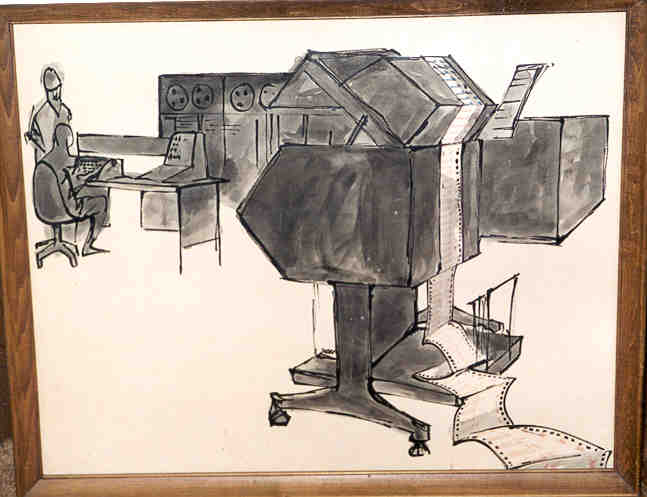

(I wish I had an IBM 1410. However, I don't! I probably would not have space for it. Also, from what I have been able to find out, there were less than 2000 of them ever built. But, I am in the process (finally!) of writing a simulator for one, now that I have at least some of the software on my wish list).
The picture above is a watercolor of an IBM 1410 Data Processing System that was used by the University of Wisconsin Registrar for a number of years. By the time I saw the system in 1970, it had been moved to the UW School of Business. It was on this system that I "cut my teeth", first as an operator, then as a programmer, and finally as a systems programmer.
The two people in the picture are standing and sitting at the IBM 1415 console. It consisted of a desk sized unit which supported an IBM Selectric console typewriter, a set of system status lights (above and behind the typewriter) and a console switch unit (to the right of the typewriter). Because the IBM 1410 was a decimal, character-oriented system, the lights were not encoded in binary, somewhat atypical as compared to most mini-computers and some mainframes of the day.
On the right hand side of the picture an IBM 1403 chain printer is depicted. The 1403 was a real workhorse, first used on the IBM 1401 Data Processing System, and it continued to be used thru the IBM 360 and 370 line. Behind the printer you can just barely see the IBM 1402 card reader/punch. Like the 1403, it too was originally developed for the 1401, and continued on thru the 360 and 370 series. Behind the console are shown several IBM 729 tape drives. The ones I worked with were dual density (200/556 character per inch) devices. They had an impressive high speed rewind. Unfortunately, the IBM 1411 Central Processing Unit and the IBM 1414 Input/Ouput Syncrhonizer are not shown in this picture. However, they were about the same height as the tape drives, and altogether were about as wide as four tape drives. So, it appears that the artist who painted this picture "doubled up" by depicting the tape drives and CPU together.
One interesting characteristic of the IBM 1410 was that it could also, at the flip of a switch, fully emulate it's predecessor, the immensely popular IBM 1401. This was quite impressive, as it was all done in hard wired logic -- it was before the days of the micro-programmed IBM 360.
I have been working on an IBM 1410 simulator. I was short sighted when I left school, and did not make copies of the system tapes, but, fortunately, with the help of Paul Pierce, was recently able to get some diagnostics and system tapes. My simulator has progressed far enough that I was able to boot, run and generate a PR-155 operating system.
However, if anyone has any programs, tapes or documentation (especially for the older PR-108 operating system) for this sytem, or an IBM 1401, please !
One bit of historical interest. The IBM 1410 was the system for which the acronym SPOOL was developed. The IBM 1410 SPOOL program (SPOOL stands for Simultaneous Peripheral Operation On Line) was used on 1410's that had replaced IBM 1401's which were often used for card-to-tape and tape-to-print operations, essentially acting as "front ends" for IBM's powerful 7000 series scientific computers of the day.
For more information on these old mainframes, especially the IBM 1401, 709 and 7090/94 computers, be sure and visit Paul Pierce's Collection page.
[Back to Jay's Home Page] [Up to the Collection] [On to the PDP-8/L and PDP-12]